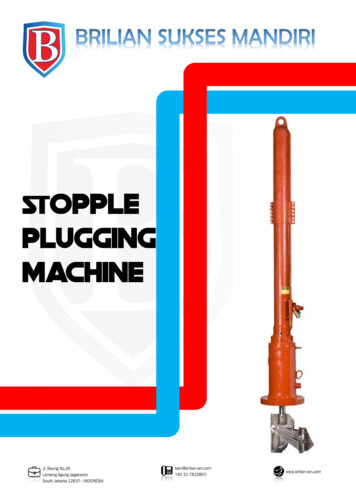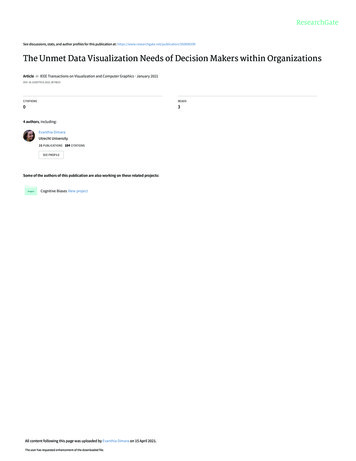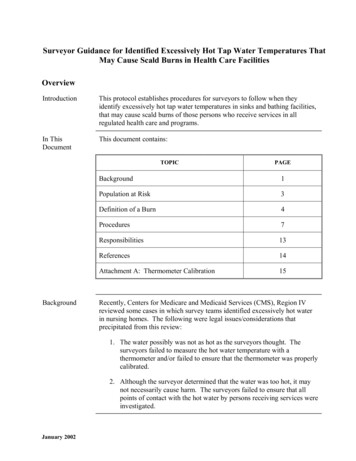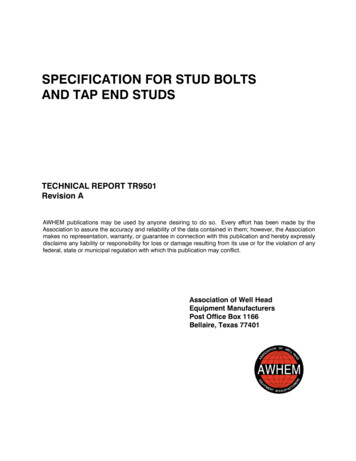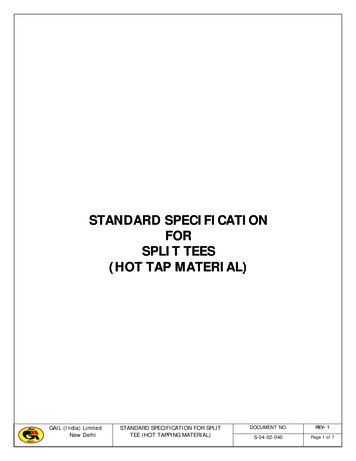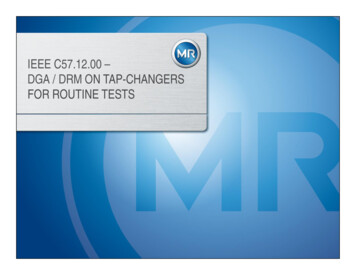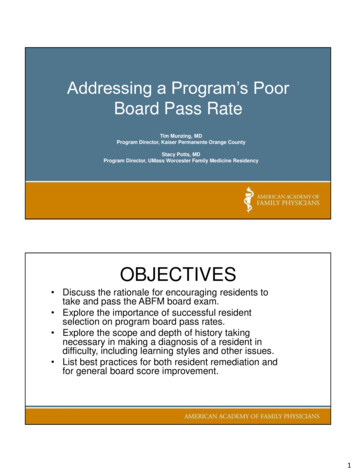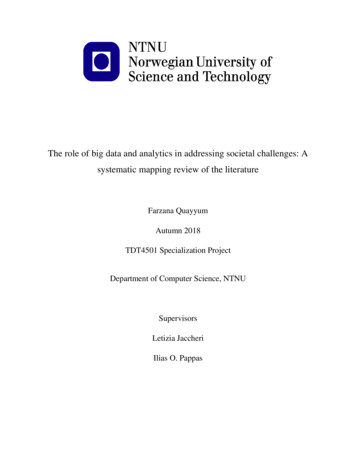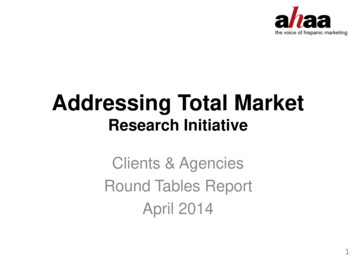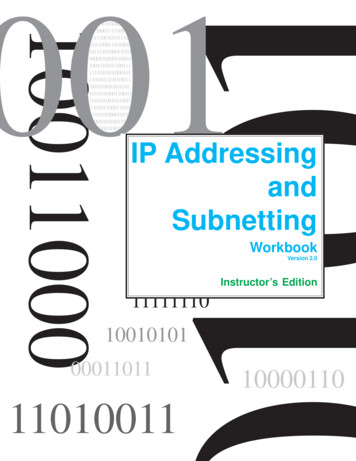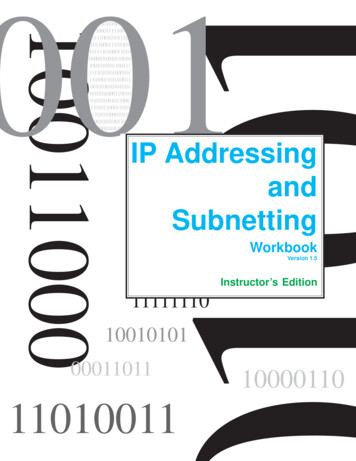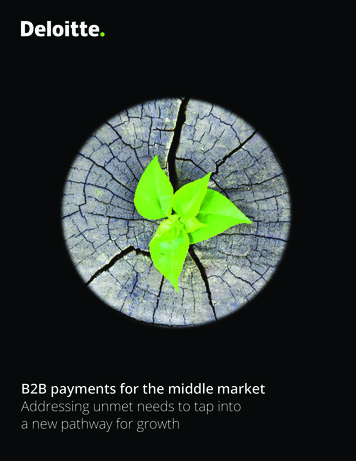
Transcription
B2B payments for the middle marketAddressing unmet needs to tap intoa new pathway for growth
The large and thriving US middle markethistorically has been largely underservedin its business-to-business (B2B)payments needs. As a result, many sellersand buyers are experiencing significantfrustration with the B2B paymentsprocess. And while financial institutions1(FIs) are increasingly targeting middlemarket growth opportunities, theycould do more to address the segment’spayments pain points.If FIs plan to tap into this new pathwayfor growth, their B2B payments offeringsshould help middle market companiesmanage broader business and growthchallenges along with addressing specificpayments pain points. This dual focus willbecome increasingly important as the USmodernizes its payments infrastructure,core processing capabilities becomecommoditized, and disruptive newcomersmove quickly to try to grab the lion’s shareof this promising market.Middle market potentialThe middle market, comprises ofbusinesses with revenue from 50million - 1 billion, is a key sector of theUS economy. With total revenues of over 6.6 trillion, the middle market leads thecountry’s economy and is growing at afast pace (Figure 1).2Middle market companies are primetargets for banking and lending services.Firms at the lower end of the spectrum( 100 million) are particularly attractive,as the segment’s average quarterlyrevenues for companies grew by 6.6percent year-over-year (YoY) in the secondquarter of 2015 (2Q15) compared toGDP growth of 2.7 percent. In the US,loans to small and medium enterprisesrepresent a quarter of all bank businessloans, amounting to 28.3 billion.3 Inaddition, employee headcount at thesefirms increased by 3.8 percent YoY,compared to the US economy’s 2.1percent employment growth in 2Q15.4Also, middle market companies are knownto have historically “sticky” relationshipswith their banks. (The average relationshiptenure is 15 years.5)Figure 1: US B2B Middle Market OpportunityThe US middle market is a key sector of the economy and grossly underservedin its payments needs63,346No. of firms320142020US B2BMarket 16.5 trillion1 23.1 trillion1US B2BMiddleMarket 3.32 trillion2 4.54 trillion2CAGR5.3% 6.6 trillion 104.6 millionTotalRevenue3Avg. revenueper firm3Transaction Volumes Represents the expected transaction volume by the end of the mentioned year by Deloitteanalysis done on IO tables published by BEA2 A ssumes % contribution of middle-market transaction volume to be in the same ratio as that forrevenue for both 2014 (20.2%) and 2020 (19.6%); Revenue contribution for middle market wasdone with data from US Census3 Deloitte analysis on data from US Census, 2012 Data only.1Today’s middle market companiesare busy figuring out how to growaggressively, both domestically andinternationally, in an ever-evolvingregulatory, competitive, and technologyenvironment. Their key priorities to meetthese objectives are to grow organically,introduce new products and services, andexpand into new markets.6 Concurrently,middle market companies are strugglingto keep costs down, seek and managetheir working capital and hire andretain employees. How middle marketbusinesses fare in the future will largelydepend on how they are able to managethese challenges, increase operationalefficiency, boost productivity, andenhance the customer experience.7Middle market companies that are dealingwith these larger issues frequently findthat payments processing inefficienciescan pose both minor irritants andmajor hurdles to their ability to conductroutine business. FIs that address theselarger issues while making paymentprocesses more efficient can differentiatethemselves in the marketplace andfurther their relationships with middlemarket clients.B2B payments landscape: Pain points,unmet needsHigh processing costs: Thirty-fivepercent of businesses report highprocessing costs as a major challenge withtraditional payment methods.8 It costs atypical Accounts Payable (AP) organizationnearly 8 to process a single9 supplierpayment. Also, 62 percent of costs stemfrom labor.10
Figure 2: US B2B payments landscape – pain points/unmet needsAccounts payable lifecycle analysis reveals 8 key pain points and unmet needsfaced by middle market buyers and suppliersHighprocessing costsPaymentdelays Middle market companies often lackthe large technology transformationbudget that is needed to automate theirpayment processes.Fraud riskKey pain pointsof middle aymentmethodsManual APprocessingRemittance dataprocessingSource: 1. Electronic Payments and Card Solutions, Paystream, 2015; 2. ePayments Rising 2014 USBank Ardent Partners; 3. APQC Research Electronic Payments and Card Solutions, Paystream, 2015;4. Altradius Payment Practices Barometer, 2014; 5. National Middle Market Summit, 2011; 6. ElectronicPayments & Remittance Data survey, Federal Reserve Banks of Minneapolis & Chicago.Payment delays: Thirty percent ofmiddle market businesses quote paymentprocessing time as a major issue.11Payment delays can result from a delay inpayment from suppliers/buyers or slowprocessing methods. It takes an averageof 30 days to complete a payment, andaround 47 percent of the suppliers arepaid late for their products or services.12Manual AP processing: Buyers lackadequate automation capabilities forAP processing due to limited back-officeintegration with electronic payments andelectronic invoices, lack of IT resources,and difficulty in convincing customers/suppliers to use ePayments.13Fraud risk: Risk of fraud is high, as thereare limited authorization controls for eachtransaction and some existing paymentmethods don’t always provide the rightlevel of security for online payments. In a2014 survey, about 22 percent of middlemarket businesses reported that theyfaced payments fraud.14Limited transaction visibility:A limited end-to-end view of thetransaction associated with multiplepayment methods results in extra costs,delays, chargebacks, and payment cycle It is difficult to move buyers andsuppliers away from familiar andubiquitous paper checks to electronicpayment methods.disruption.Supplier payment methods: Amismatch in the payment methodspreferred by buyers and supplier alsoposes challenges; buyer paymentdecisions are heavily dependent on thepayment methods their suppliers use.Remittance data processing:Reconciling multiple invoices and receivingand processing remittance data canbe cumbersome due to missing dataelements in the files, use of different fileformats, and lack of back-office supportfor automated remittances.15These pain points in the 3.3 trillion16– and growing – middle market B2Bpayments processing space, haven’treceived the same degree of attentionfrom FIs as consumer payments orcorporate payments aimed at largecompanies. A few factors thatcomplicate middle market B2Bpayments processing are: Middle market B2B payments processesare typically more difficult to automate. B2B payments require integration withdiverse Enterprise Resource Planning(ERP)/AP platforms. The financial services industry in generalhas been too busy processing consumerpayments and managing regulatory andcost challenges to focus on addressingthe complex problems of middle marketB2B companies.The middle market is ripe fordisruption: While a few FIs are beginningto introduce B2B payments solutions,most of the segment’s innovation is beingdriven by nimble financial technology(fintech) companies and other disruptorswhich are leveraging business andtechnology trends (see discussion onnext page) to develop innovative solutionsthat alleviate many payments processpain points. Fintechs have developedtargeted solutions around peer-to-peerlending, online trade finance, invoicefinance to meet the needs of middlemarket businesses.17 There are more than30 non-bank platforms across the globethat enable middle market companies toraise capital up to 1 million to fund theirgrowth and operations.18For example, Western Union recentlylaunched WU Edge, a digital platformdesigned to enable small- and mediumsized enterprises (SMEs) to tradeinternationally.19 Similarly, ReceivablesExchange provides a real-time onlinemarketplace for working capital financingfor mid-sized businesses.Now may be the time for FIs to takeaction if they want to tap into this newpathway for growth. Traditional banks andpayment card companies that are slow torespond may risk getting squeezed-out bymarket upstarts. However, FI paymentsproviders that are able to harnessthese trends and differentiate their B2Bofferings could be well-positioned tocapitalize on anticipated robust middlemarket growth.20
Trends fueling middle market B2B payments competitionA number of trends are creating footholds for non-traditional competitors to better serve the middle-market’s B2B paymentprocessing needs:Digitization (shift to ePayments) Digitization of B2B commerce and growth of B2B networks – There is increasing focus on B2B e-commerce market sales,currently rising at 7.7 percent CAGR and forecast to reach 1.13 trillion by 2020. 74 percent of B2B buyers today research at leastone-half of work-related purchases online, and 30 percent complete at least half of their work-related purchases online.21 Rising marketplaces – A burgeoning crop of e-marketplaces (such as Alibaba and Amazon Business) is appealing tomanufacturers, wholesalers, and distributors with potential for access to new markets and growth. E-marketplaces also are apopular solution for wholesalers and distributors unable or unwilling to build their own-ecommerce engines. Shift from checks to other electronic payment methods – Despite traditional high usage of checks as a form of payment,many businesses are shifting to more evolved methods of electronic payments. Seventeen percent of deposited checks areimage deposits, 93 percent of image deposits are by businesses, and 71 percent of businesses are capable of making electronicpayments.22Differentiation through adjacent offerings Working capital/financing needs – There is an increasing need for supply chain financing, aiming to improve financialefficiency and reduce the working capital needs of both buyers and suppliers. Supply chain financing allows buyers toextend payment terms while providing suppliers access to better financing rates. In a Deloitte survey of mid-marketexecutives,23 over 28 percent of firms indicated that they would pursue working capital lines of funding over the next yearto help grow their business. Incentives/dynamic discounting – Innovative dynamic discounting solutions are emerging (for example, by Taulia), whichprovides an online negotiations platform that enables buyers to accept early payment offers from suppliers and allows forvariable discounts depending on the early payment date and the amount accelerated. Analytics – Buyers and suppliers are using advanced analytics to gain insights to grow their business and evaluate theirprocurement-to-payment operations, identify roadblocks, and improve efficiencies (e.g., monitor spending data, costmanagement, fraud reductions, decision management and cross-selling). Nearly 40 percent of respondents to a Deloittemiddle-market survey24 said predictive analytics held the most potential to forecast business events and help their businessesbe prepared.Capitalize on innovation in consumer payments and other business and technology areas Faster payments – As suggested by the Federal Reserve, several payments industry entities - including NACHA (the electronicpayments association), The Clearing House, and ClearXchange— have undertaken projects with the goal of speeding upelectronic payments in the US, enabling same-day or real-time payments.25 Rise of blockchain - Disruptive new business models are paving the way to bring blockchain into the mainstream B2Btransaction payment processing industry. Digital currencies or cryptocurrencies (Bitcoin), although in their infancy, areattracting interest due to the potential of their blockchain infrastructure to transform payments processes. Bitcoin, for example,is less expensive than wire transfers, faster than ACH transfers and provide a way to bypass bank fees.26 Proliferation of mobile payments - Similar to B2C, the use of smart phones, tablets and social media platforms is becomingcommonplace in B2B; the challenge for B2B firms is to successfully incorporate these channels within existing e-commerceactivities. Cloud - Cloud computing uses technology to create business advantage through resource sharing. Cloud is built for multiplechannels, shared applications and data. It enables the extension of services outside an institution’s firewalls across nontraditional service boundaries and providers. According to a recent Deloitte survey, over 21 percent of middle-market firms whoresponded have successfully deployed cloud-based solutions in their businesses, while another 43 percent are in the process ofbuilding them.27 Cloud-based ERP, CRM and invoice processing has direct implications for institutions that are trying to capturethis market.
Enhancing the FI value propositionEasing middle market B2B paymentspain points will be table stakes for FIs.Payments processing increasingly willbecome commoditized, especially withthe US Federal Reserve driving towardsubiquitous and faster payments.28 Toenhance their value proposition andcompete effectively over the long term,FIs also should help middle marketcompanies manage ongoing businessand growth challenges. For example,cash flow predictability is often impairedby inflexible payment terms offeredby different suppliers, and heavilyimpacts buyer and supplier workingcapital availability. Close to 55 percentof middle market players find it highlyor moderately challenging to maintainsufficient working capital.29 Similarly,there is significant opportunity for FIsto provide valuable business insightsby harnessing the payments data andcombining it with other types of data (E.g.,Payments data can provide insight intopricing, asymmetrical contracts, supplychain performance etc.). By developinginnovative payments products thataddress larger-picture issues such asworking capital, FIs can differentiatethemselves from fintechs and othermarket entrants, especially as thepayments process itself becomescommoditized through ubiquitous, fasterpayments schemes. In preparation, FIsshould consider developing a strategybased on three pillars for an enhancedvalue proposition (Figure 3):1. Strengthen core capabilities.Cater to customer paymentsprocessing pain points and tablestakes expectations across traditionalpayment modes by reducing costs,increasing speed, and improvingefficiencies.2. Create proprietary bundledsolutions. Understand the largerbusiness issues that the middlemarket faces and develop products/offerings that go beyond providinga seamless payments experienceto help companies leverage thesynergies between payments andbusiness solutions. Through theseofferings FIs can create differentiationand continue to play in this marketas core payments processes becomeincreasingly commoditized.Figure 3: B2B payments game plan - strategy planning frameworkPayment MethodsUnmet Needs/Pain PointsCustomer Segmentsand MarketsIncrease SpeedDemographicImprove EfficiencyGeographicProvide DifferentiatedCustomer ExperienceIndustriesCardsCapabilitiesBuild New CapabilitiesPartner/AcquireNew CapabilitiesProprietaryInnovativeCoreSupport Business GrowthAddress WorkingCapital/Financing NeedsImprove ExistingCapabilitiesACH/WiresReduce CostExtendedIntegrate IntoCommerce ProcessProvide IncentivesAddress IndustryVertical NeedsOther InnovativeStrategiesExistingInnovativeExtendedNew (Partner, Greenfield)3. Harness “greenfield” innovation.Develop new B2B payments productsand services for the middle marketthat harness the power of disruptivetechnologies (e.g., cloud, mobile,digital currencies, real-time payments,etc.) and leverage partnerships andinvestmentsin innovative fintechs to fillcapability gaps.In addition, FIs likely will need to acquireor build organizational capabilities that willenable them to address middle marketpain points. Important steps are to assessorganizational gaps, adopt capabilitiesexternally through partnerships and/oracquisitions, and plan investments forcapabilities that must be built internally.Go-forward strategies for growth shouldinclude a focus on customers’ segmentspecific needs; adjacent products andservices; and clear differentiation basedon three principles: Mind clients’ needs as your own.Place emphasis on clients’ broaderbusiness needs, not just immediateexpectations around the paymentsprocess. It is increasingly criticalto understand clients’ businesscircumstances and provide solutionsthat address these needs (e.g., industryvertical-specific solutions). Be present where your clients are.Customize offerings to customers’demographical, geographical, andbehavioral characteristics. Forexample, middle market companies areincreasingly congregating around B2Bmarketplaces. Integrate B2B payments processinginto existing solutions. Reduce thefriction associated with adopting newerpayment services by creating solutionsthat integrate easily with customers’existing systems and capabilities. Forexample, FIs may look to integratetheir payments methods into a client’ssystems (e.g., ERP systems) and procureto-pay processes, especially consideringconstrained human capital resources atmiddle market companies.
New pathway for growthThere is a tectonic shift underway in theB2B middle market payments landscape,with increasing numbers of serviceproviders offering specialized productsand services to address buyer/seller painpoints. Traditional financial institutionsmay be particularly vulnerable todisruptive competition that they haven’texperienced in their core banking andlending services. Barriers to entry havelargely been eroded by a combinationof technology and disruptive businessmodels that are making it easier forsmaller players to do what only thelarger banks were able to previously.FIs can and should tap into this newpathway for growth.ContactsTushar PuranikDirectorDeloitte Consulting LLPtpuranik@deloitte.comDivakar GoswamiSpecialist LeaderDeloitte Consulting LLPdgoswami@deloitte.comEndnotes1Including banks, card issuers, and card networks2Winning in middle-market banking, Deloitte University Press, 20163SMEs rising to their potential with Fintechs, Traxpay4Winning in middle-market banking, Deloitte University Press, 20165Winning in middle-market banking, Deloitte University Press, 20166America’s economic engine: Tapping the brakes, Deloitte, 20167 Technology in the mid-market: Perspectives and priorities,Deloitte, 20148Electronic Payments and Card Solutions, Paystream, 20159ePayments Rising: The 2014 Market Report, Ardent Partners, 201410 APQC Research Electronic Payments and Card Solutions,Paystream, 201511Electronic Payments and Card Solutions, Paystream, 201512Altradius Payment Practices Barometer, 201413 Electronic Payments & Remittance Data survey, Federal ReserveBanks of Minneapolis & Chicago, 201214 Middle-market businesses on losing end of payment fraud, JavelinStrategy, 201415 Electronic Payments & Remittance Data survey, Federal ReserveBanks of Minneapolis & Chicago, 201216 B2B Middle market transaction volume by the end of 2014 basedon IO tables published by U.S. Bureau of Economic Analysis (BEA)and Deloitte analysis17Deloitte analysis; The Unicorn list, CB Insights, 201618 The Future of FinTech A Paradigm Shift in Small Business Finance,World Economic Forum, 201519 Western Union Launches ‘WU EDGE,’ A Ground- Breaking DigitalB2B Platform to Drive SME Growth Internationally, Western UnionPress Release, April 4, 201620 Fintech New York: Partnerships, platforms and open innovation,Fintech Innovation Lab, 201521 US B2B eCommerce Forecast: 2015 To 2020, Forrester Research,April 2, 201522Electronic Payments and Card Solutions, Paystream, 201523 Mid-ma
Capitalize on innovation in consumer payments and other business and technology areas Faster payments – As suggested by the Federal Reserve, several payments industry entities - including NACHA (the electronic payments association), The Clearing House, and ClearXchan
